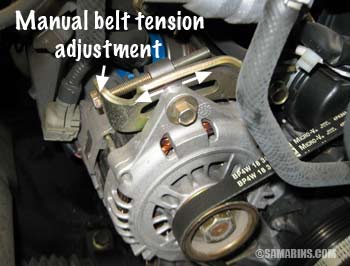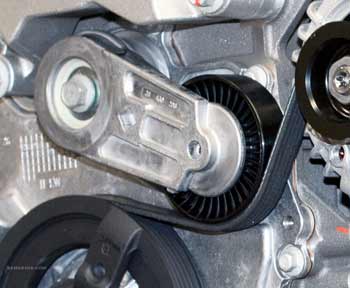A drive belt drives the accessories installed on your engine such as the alternator, power steering pump, water pump and the air conditioner compressor. Most modern cars have one or two drive belts. If there is only one drive belt, it might also be called a “serpentine belt.”
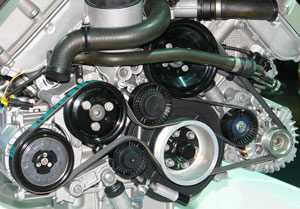 Although it’s made of a very durable rubber-based material, the drive belt still wears over time. On average, a drive belt lasts for 45,000-75,000 miles or 3-5 years. A worn-out drive belt may cause squeaking or chirping noises and a badly-worn drive belt can break. If the drive belt breaks, your car won’t be driveable. If the engine runs without a drive belt, it might overheat as the water pump will stop circulating antifreeze (cooling fluid) through the radiator to cool the engine down. The battery light might come on on the dash because the alternator will stop charging the battery. A car with a hydraulic power steering will also lose the steering assist, so the steering will become very stiff.
Although it’s made of a very durable rubber-based material, the drive belt still wears over time. On average, a drive belt lasts for 45,000-75,000 miles or 3-5 years. A worn-out drive belt may cause squeaking or chirping noises and a badly-worn drive belt can break. If the drive belt breaks, your car won’t be driveable. If the engine runs without a drive belt, it might overheat as the water pump will stop circulating antifreeze (cooling fluid) through the radiator to cool the engine down. The battery light might come on on the dash because the alternator will stop charging the battery. A car with a hydraulic power steering will also lose the steering assist, so the steering will become very stiff.
When a drive belt needs to be replaced
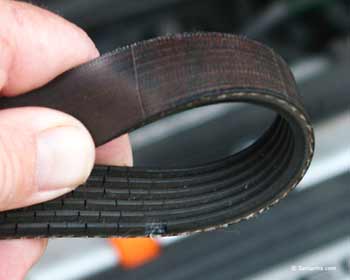
Worn out drive belt
|
Most car manufacturers don’t specify the drive belt replacement intervals, but rather recommend inspecting it during regular services once your vehicle reaches a certain mileage. For example, this is what Toyota recommends for the 2012 Toyota Camry drive belts:
Initial inspection at 60,000 miles/72 months. Inspect every 15,000 miles/18 months thereafter.
Your mechanic will look for cracks, splits, damaged edges, missing chunks, glazing and other signs of wear. Usually it’s fairly easy to see when the belt is worn out. A worn-out belt must be replaced. A drive belt must also be replaced if it is found to be soaked in oil, or stretched. If your car has two drive belts, both are usually replaced at the same time. It’s also a good idea to replace an old drive belt before a long road trip.
Drive belt tensioner
To work properly, a drive belt must be under proper tension. In older cars, belt tension had to be adjusted manually, see the photo. Typically, you would hear a loud screeching noise when the engine is started if the drive belt is loose. In cars with manual adjustment, the belt tension must be checked during regular services and adjusted as necessary. |
|
Today, most cars are equipped with maintenance-free spring-loaded (in the photo) or hydraulic belt tensioners. It’s not necessary to replace a belt tensioner whenever a drive belt is replaced. A drive belt tensioner must be replaced only if it is failed. For example, a tensioner could be seized or the tensioner bearing could be noisy. Sometimes a seized belt tensioner may even cause the serpentine belt to slip out. A failed hydraulic belt tensioner often produces a rattling noise. If you suspect that your drive belt tensioner has failed, your mechanic can check if the tensioner works properly. In most cases, a belt tensioner is fairly easy to replace and not very expensive. |
What can cause a drive belt to wear prematurely
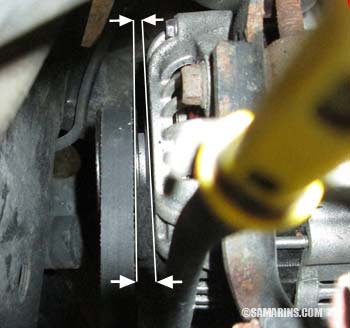
Misaligned alternator
|
A number of factors can cause a drive belt to wear prematurely. For example, in this car, in the photo, a drive belt needed to be replaced every three months. Upon closer inspection, we found that the alternator was installed improperly, under angle. Click on the photo to see the larger image. This caused the alternator pulley to be misaligned with the belt, so the belt was wearing out faster.
A damaged or missing engine undershield can also cause a drive belt to wear faster. An undershield protects the belt from dirt, sand and water. If the undershield is missing, water and small rocks can get under the belt and wear it faster. Improper tension, oil and coolant leaks can also cause the drive belt to wear faster.
Common questions:
A: You always can ask your mechanic to show you why the belt needs to be replaced; usually when you compare an old and new belt, it’s easy to see. Another thing, look at the mileage, when have you had your drive belt(s) done last time? If it’s more than 40,000 miles or 3-4 years ago, it is safe to say that your belt will have some signs of wear and tear.
A: First, you’d have to have more than basic mechanical skills, proper tools and the belt diagram. In many front-wheel drive cars with a transversely-mounted engine, the space between the engine and the frame is very limited. To gain access to the drive belt, you might have to jack up the car, take the front wheel out and remove the engine side cover. In some cars it’s easy to release the tensioner; in others it might be very tricky. In many cases a special tool is needed to release the belt tensioner. Often, when replacing a belt, you might find out that the tensioner is seized or the belt that you got doesn’t fit, so be prepared to visit your parts store again. All in all, we would recommend getting the quote from a local repair shop or your dealer first. If you think it’s still worth a try, start by finding the correct repair procedure with pictures or a how-to video that explains how to do it for your car make and model.
A: No, a “cam belt” is another name for a timing belt, which is the one that drives engine camshafts. A timing belt has teeth on one side and is hidden under the covers, while a drive belt is visible from the outside.
A: If you said that the noise started after the alternator has been replaced, we would recommend to recheck the alternator installation. The noise you described could happen when the belt pulleys are not aligned properly. Maybe the alternator was not installed correctly or the belt pulley on the alternator is not seated properly.
A: It could be a failing belt tensioner which was a fairly common problem in this car. Have it checked out.


